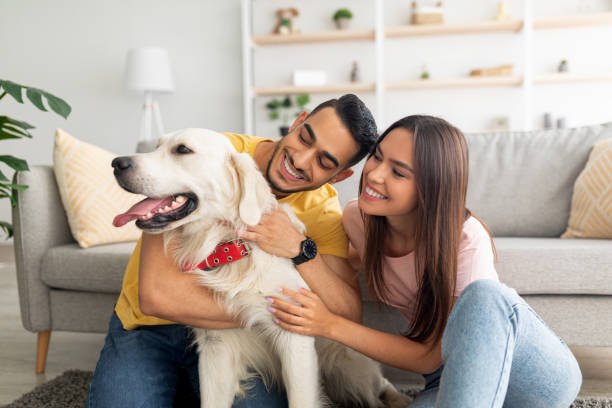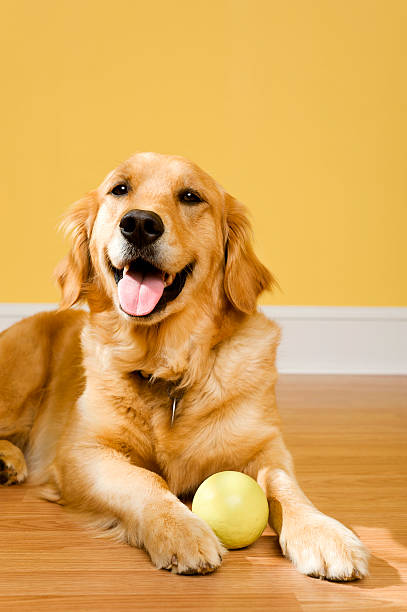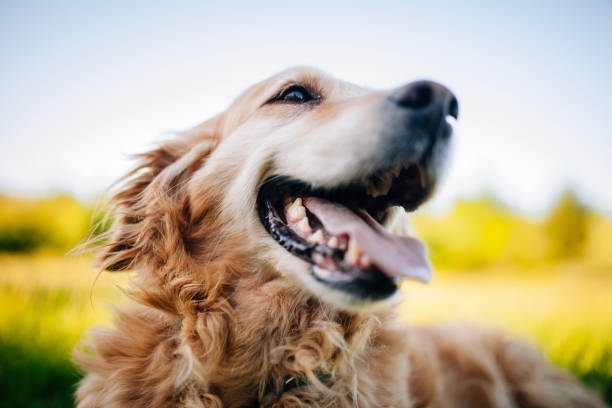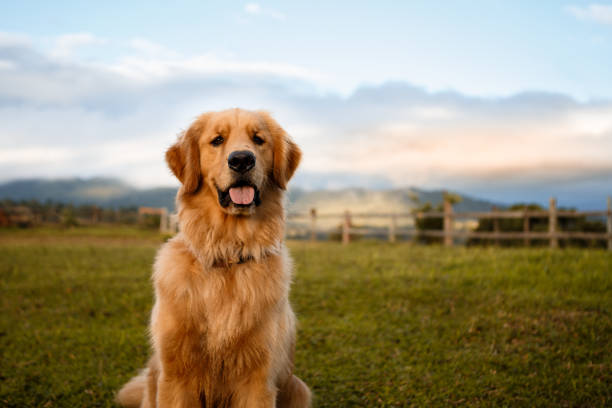
The Golden Retriever dog breed is pickup from Scotland and it is medium in size and know for its good behavior and has a golden slicky hair . Golden’s loving and playful temperament makes it a great pet for individuals and households. They are also highly intelligent and empathetic, often characterising their roles as service dogs and treatment dogs. Golden Retriever is one the most loving dog breed in America .
Due to high energy levels and care needs, golden retrievers can pay attention to some people. Your gorgeous coat needs to be regularly watched to avoid mats, especially during the scale season, and your active head needs a lot of mental stimulation. It requires significant engagement and is especially prone to separation anxiety; therefore, it should not be left alone for long periods.. However, if you can provide these basics, You will receive love and loyalty in return from the Golden Retriever, making it a rewarding companion.
Golden Retrievers Coat and color variations
The distinctive silky coats of golden retrievers are characterized by water-resistant undercoats and outer layers that can be either wavy or straight. Her coat is undoubtedly beautiful, but he serves a practical purpose, protects from the elements and is isolated from the rainy weather of his home town of Scotland. However, potential owners should note that these dogs will have heavy dandruff all year round and more intensive dandruff during the season. Regular care not only helps deal with dandruff, but also ensures that your coat remains healthy and well maintained.
The iconic golden hue is typically associated with the breed; however, golden retrievers come in a range of shades, spanning from pale cream to deep red. The American Kennel Club (AKC) racial standards exclude pale or excessive dark shades. There are also regional variations, with European golden retrievers often lighter, with a rich, reddish tone of cream coats, British cream golden retrievers and Canadian golden retrievers.

Golden Retriever history
For numerous a long time, a legend was that Brilliant Retrievers were plummeted from Russian sheepdogs bought from a circus.The breed was actually developed in Scotland on the estate of Sir Dudley Majoribanks, who later became known as Lord Tweedmouth . Tweedmouth, like numerous upper class of his day, bred creatures of all sorts, attempting to idealize diverse breeds. Tweedmouth’s breeding records from 1835 to 1890 appear what he was pointing for with the Brilliant: A gifted retriever — Tweedmouth was an enthusiastic waterfowl seeker — with a wonderful nose, who would be more mindful to his human chasing companion than the setters and spaniels utilized at the time for recovering. He too needed the canine to be loyal and even-tempered within the domestic.
Tweedmouth took Nous domestic to Scotland and, in 1868 and 1871, bred him to Beauty, a Tweed Water Spaniel. Tweed Water Spaniels (now extinct) were known for being enthusiastic retrievers within the chasing field and especially calm and faithful within the domestic — characteristics you’ll discover in today’s Brilliant Retrievers. Nous and Belle’s family members were interbred with Wavy- and Flat-coated retrievers, another Tweed Water Spaniel, and a ruddy setter. Tweedmouth kept for the most part the yellow puppies to proceed his breeding program, and gave others absent to companions and relatives. Not shockingly, Tweedmouth’s breed to begin with pulled in consideration for their abilities within the hunting field. Among the most renowned was Wear of Gerwyn, a liver-coated descendant of a Tweedmouth dog, who triumphed in the Worldwide Gundog Alliance trial in 1904. In 1911, the Pet Hotel Club in Britain officially acknowledged the Brilliant Retriever as a distinct breed.
They were at that point classified as “Retriever — Yellow or Golden.” In 1920, the breed title was authoritatively changed to Brilliant Retriever. The American Pet hotel Club recognized the breed in 1932.At present, the Golden Retriever is the third most sought-after breed in the U.S., trailing behind the French Bulldog and the Labrador Retriever.
Behavior and personality traits
- Agreeable: Appreciates being around individuals and other creatures.
- Tender: Normally understanding and incredible with children.
- Shrewdly: Quick learners who surpass expectations in both preparation and problem-solving skills.
- Steadfast: Shapes solid enthusiastic bonds with family individuals.
- Lively: Keeps up a young, lively soul all through their lives.
- Versatile: Adapts seamlessly to various living environments and lifestyles..
- Non-aggressive: Inviting deportment, seldom shows regional or forceful behavior.
- Warm: Flourishes on physical love and companionship.
Training and socialization
Golden Retrievers are known for their pleasant temperament and enthusiasm; however, they require early socialization and consistent training to develop into balanced and well-adjusted adults. Despite their reputation for being easy to make, some owners may underestimate the importance of reinforcing basic commands. Without proper guidance, their high energy levels can lead to challenges. manifest in undesirable actions such as reckless chewing, leaping, pulling on the leash, or overly enthusiastic play with their mouths—an instinctive behavior.. connected to their bird-dog parentage. Devote time and exertion to preparing your Brilliant Retriever to guarantee they ended up a well-behaved and cheerful companion!

How to groom a Golden Retriever
Brushing and bathing
- Brush 2-3 times a week; daily during shedding seasons. Work in sections, starting at the head and moving down the body.
- Bathe every 6-8 weeks (or when needed) using a dog-safe shampoo.
- Check and clean ears
- Inspect the ears weekly for dirt, wax, or redness.
- Use a vet-approved ear cleaner and cotton ball to gently clean.
- Trim nails and fur
- Clip nails every 3-4 weeks or when you hear them clicking on the floor. Use a nail grinder or clipper, being careful not to cut the quick.
- Use scissors or thinning shears to trim around the paws, ears, and tail for a neat appearance. Avoid cutting too close to the skin or over-trimming.
- Inspect overall condition
- Look for skin irritations, lumps, or signs of fleas/ticks during grooming.
- Consult a vet if you notice anything unusual.
- Keep up with flea and tick prevention treatments, especially if your Golden spends much time outdoors. Regular grooming allows you to spot parasites early.
- Seek for skin disturbances, knots, or signs of fleas/ticks amid preparing.
- Counsel a vet in case you take note anything bizarre.
- Keep up with insect and tick avoidance medicines, particularly in case your Brilliant spends much time outside. Customary prepping permits you to spot parasites early.
Nutrition and feeding
Prescribed day by day sum:
2 to 3 mugs of high-quality dry nourishment a day, partitioned into two dinners. How much your grown-up puppy eats depends on his measure, age, construct, digestion system, and action level. Pooches are people, similar to individuals, and they do not all require the same sum of nourishment. A profoundly dynamic puppy will require more than a love seat potato pooch. The quality of canine nourishment you purchase moreover makes a distinction — the better the pooch nourishment, the assist it’ll go toward nourishing your puppy, and the less of it you’ll ought to shake into your dog’s bowl.
Keep your Brilliant in great shape by measuring his nourishment and bolstering him twice a day instead of taking off nourishment out all the time. On the off chance that you’re uncertain whether he’s overweight, allow him the eye test and the hands-on test. To begin with, see down at him. You ought to be able to see a midriff. At that point put your hands on his back, thumbs along the spine, with the fingers spread descending. You ought to be able to feel but not see his ribs without having to press difficult .
Portion guidelines
Puppies (8 weeks – 12 months)
- Meals per Day: 3-4 smaller meals to support steady growth.
- Portion Size: 1-3 cups daily, divided based on age, size, and activity level.
Adults (1-7 years)
- Meals per Day: 2 meals to maintain energy and weight.
- Portion Size: 2-4 cups daily, adjusted for size, activity, and metabolism.
Seniors (7+ years)
- Meals per Day: 2 smaller meals to avoid overeating.
- Portion Size: 1.5-3 cups daily, with fewer calories if activity decreases.

Are Golden Retrievers good with kids?
The genial Brilliant Retriever isn’t bothered by the commotion and commotion of kids — he flourishes on it. He’s a huge, solid pooch, in spite of the fact that, and he can effortlessly thump over a little child by botch. As with each breed, you ought to continuously educate children how to approach and touch mutts and continuously administer any intelligent between mutts and youthful children to anticipate any gnawing or ear or tail pulling on the portion of either party.
Educate your child never to approach any canine whereas it’s eating or resting or to undertake to require the dog’s nourishment absent. No pooch, no matter how inviting, ought to ever be cleared out unsupervised with a child. The Golden’s state of mind toward other pets is the more, the merrier. He appreciates the companionship of other mutts and, with legitimate presentations and preparing, can be trusted with cats, rabbits, and other creatures.
